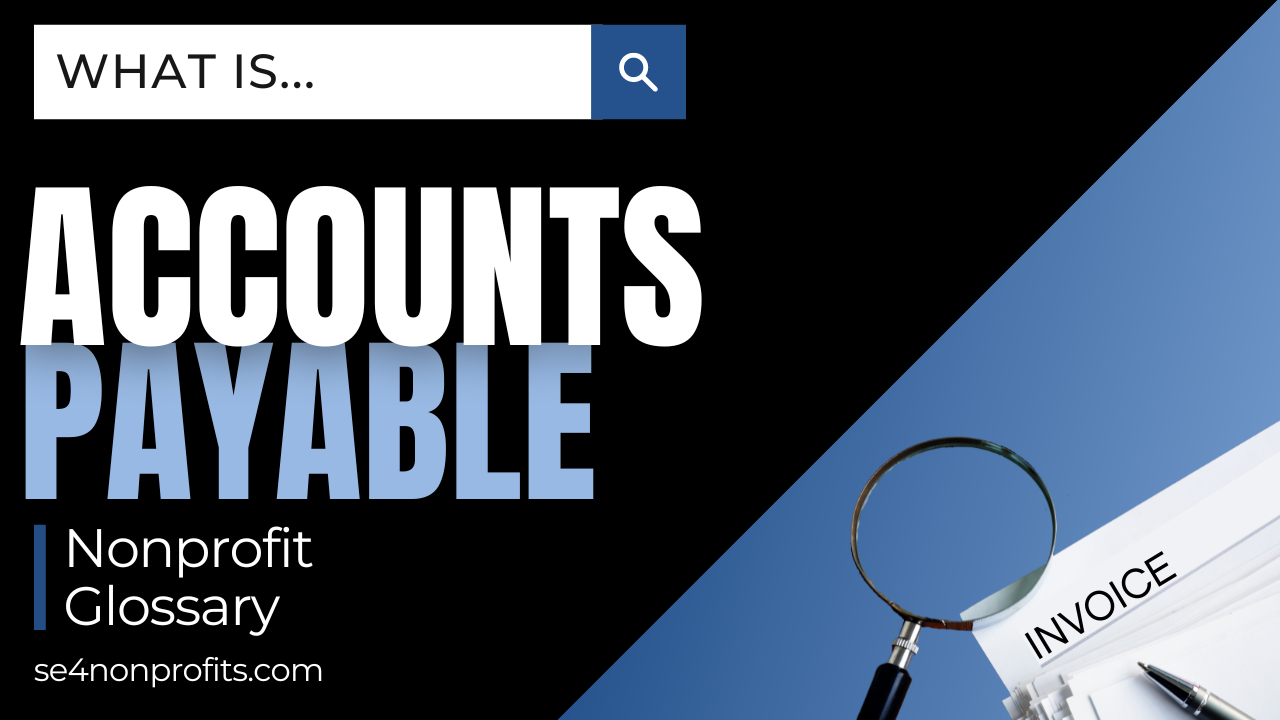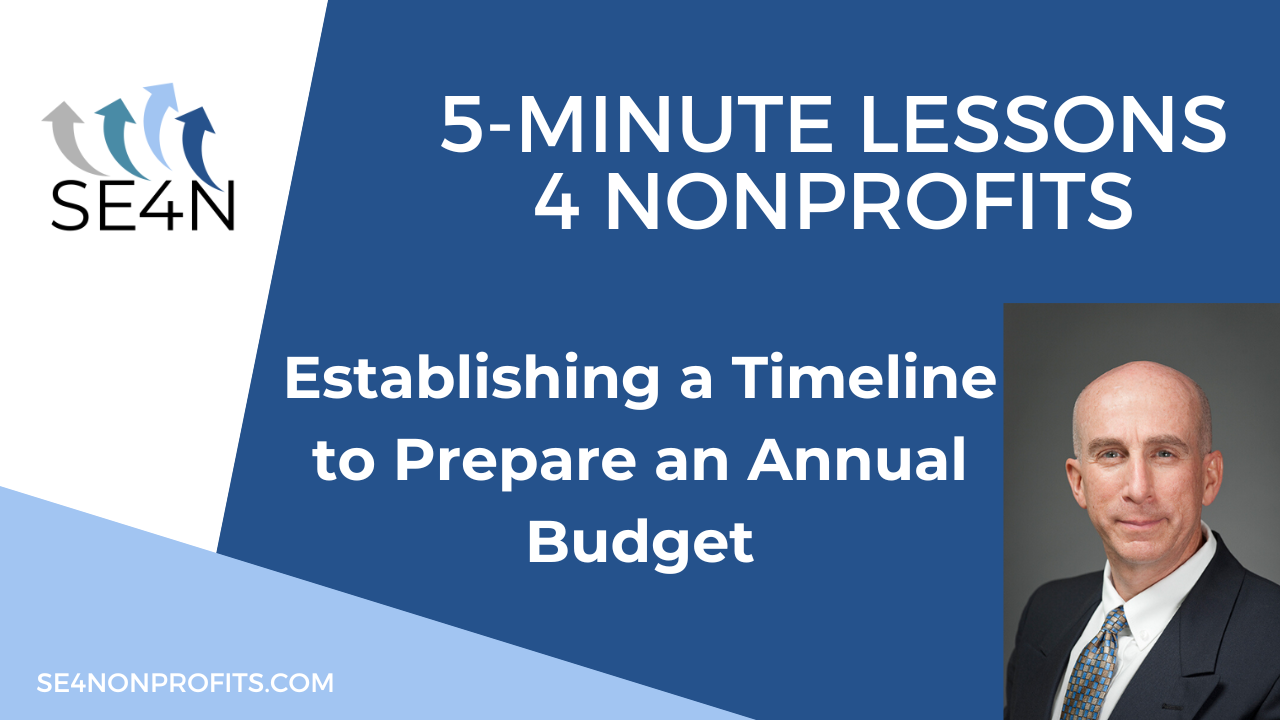
Blog.
Most Recent Posts

VIDEO: What is a Prepaid Expense? | Nonprofit Glossary
SE4N's A. Michael Gellman provides a short summary of the definition of a prepaid expense, how prepaid expenses show up on the balance sheet, and how prepaid expenses impact the operations of #nonprofit organizations.

VIDEO: Getting a Tax ID Number (EIN) for a New Nonprofit | 5-Minute Lessons 4 Nonprofits
SE4N’s Benjamin Takis provides a short lesson on how to get a tax ID number (also known as employer identification number or EIN) for a new nonprofit organization, including tips for how to most quickly and efficiently obtain the EIN and a guided walk-through of the process using the actual online application (Form SS-4) on the IRS website.

The Case Against Board “Give or Get” Policies for a Nonprofit Organization
For nonprofit organizations, especially public charities, individual Board member giving is almost always a sensitive subject. Board giving is usually an important benchmark for nonprofits and frequently is treated as a “badge of honor” when an organization can report that 100% of its Board members have made an annual contribution. Board “give or get” policies may help some organizations reach Board giving goals, but they are complex and often hard to enforce, quantify, and manage.

Q&A #158 – What happens if a fraudulent Form 1023-EZ is filed for my organization?
Despite what some unscrupulous service providers may tell you, there are potentially serious penalties for submitting a Form 1023-EZ application for an organization that is clearly ineligible to do so. In addition to revocation of 501(c)(3) status, this can include criminal fines and even prison pursuant to the Internal Revenue Code’s fraud and false statements provisions (26 U.S.C. § 7206). However, if a Form 1023-EZ was fraudulently filed without your knowledge, approval, or participation then these criminal sanctions very likely will not apply.

VIDEO: What is a Quid Pro Quo Contribution? | Nonprofit Glossary
SE4N's Benjamin Takis provides a short summary of the term "quid pro quo contribution," how it affects a donor's use of the charitable deduction, and what obligations to apply to nonprofit organizations that receive donations that are partly in exchange for goods or services.
![In the Search for Professional Services, Caring is as Important as Knowledge [SUBSCRIBERS-ONLY]](https://images.squarespace-cdn.com/content/v1/5e6ccadfb4659c1d51df14d5/1695143467556-O18KCGS7N8B5ZC1UWH9G/jc-gellidon-EH9f0TI5wco-unsplash.jpg)
In the Search for Professional Services, Caring is as Important as Knowledge [SUBSCRIBERS-ONLY]
In the search to find the best professional service providers such as attorneys, accountants, consultants, investment advisors, and real estate brokers, nonprofits often overemphasize subject matter expertise and knowledge. However, if the service provider does not display a caring attitude and willingness to understand the organization’s unique needs, mission, and culture, the results will not be what the organization expected.

What Many Nonprofits Misunderstand About Employee Probationary Periods
A new hire’s first few months with a nonprofit organization is a crucial time for onboarding, communicating expectations, and setting up the employee to achieve success. However, the common framing and messaging of this time as a “probationary period” has led to many misunderstandings about the legal status of new employees and what employers should be aspiring to achieve during this introductory phase.

VIDEO: What is Accounts Payable? | Nonprofit Glossary
SE4N's A. Michael Gellman provides a short summary of the definition of accounts payable, the distinction between accounts payable and accrued expenses, and key considerations nonprofit organizations should keep in mind when dealing with accounts payable.

Q&A #157 – What are the legal limits of an Executive Committee’s authority?
Executive Committees are often granted wide-ranging authority to the to act on behalf of a nonprofit organization and exercise the powers of the Board of Directors in between Board meetings. Absent additional, clarifying language in the Bylaws, committee charter, or Board resolutions, there are generally few legal limitations on an Executive Committee’s authority. However, there are some explicit and implicit limits that are important to consider

Defining the Purposes and Roles of the Executive Committee
The executive committee (EC) can be one of a nonprofit organization’s most powerful governance tools. However, ECs are often poorly positioned and structured, with too much emphasis on who sits on the EC and too little thought about how it will be used. Reimaging and restructuring your organization’s EC with a focus on its purposes and roles will pay big dividends in the future.

VIDEO: Establishing a Timeline to Prepare an Annual Budget | 5-Minute Lessons 4 Nonprofits
SE4N's A. Michael Gellman provides a short lesson on the scheduling and timing of the different phases of the budget building process for nonprofit organizations, including how much time to allot for budget preparation and approval and how to structure a work plan for creating initial and final drafts of the budget, seeking feedback from staff, management, and Board members, through the end of the budget approval process.

Q&A #156 – Who is considered a family member under nonprofit conflict of interest rules?
Extended family members such as aunts, uncles, and cousins generally fall outside of the technical definition of “family members” under the federal tax code provisions governing conflicts of interest involving 501(c)(3) nonprofit organizations. However, these types of relationships can certainly lead to the perception that there is a conflict and should be treated as such to avoid the risk of damaging your organization’s reputation.

VIDEO: What is the 501(h) Election? | Nonprofit Glossary
SE4N's Benjamin Takis provides a short summary of the 501(h) election, how it affects the lobbying limits applied to 501(c)(3) nonprofit organizations, how the 501(h) "expenditure test" is different from the "no substantial part" test, and how a public charity makes the 501(h) election.

The Functional Approach to Budgeting for Expenses
Often, we refer to the size of a nonprofit organization by the total expenses within its annual operating budget. This emphasizes the important role of expenses in the budget while also serving as a measure of an organization’s capacity to provide programs and services. To get the best possible budget for expenses, nonprofits should use a functional (programmatic) approach that better displays the cost of programs, activities, and operations and encourages staff ownership and accountability.

Q&A #155 – Can a nonprofit convert to 501(c)(3) status from another tax-exempt status?
An organization that was previously recognized as tax-exempt under another subsection of 501(c), such as 501(c)(4) or 501(c)(6), generally may convert to 501(c)(3) status by making the necessary amendments to its Articles of Incorporation and submitting a Form 1023 application to the IRS. However, there may be complications to this process if the organization’s activities have not been consistent with 501(c)(3) status.